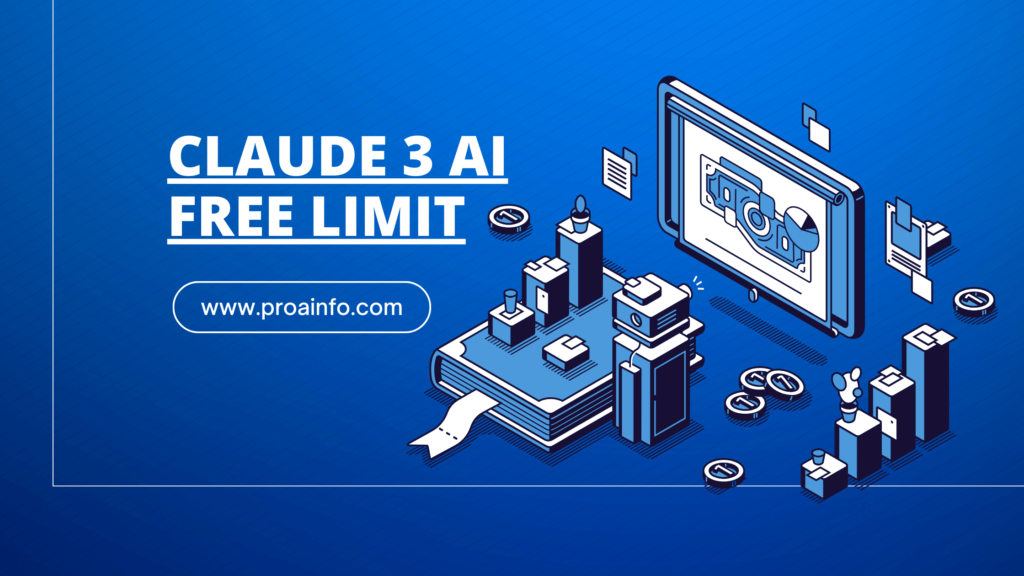Claude 3 AI Free Limit. In the ever-evolving landscape of artificial intelligence, one name has been making waves and captivating the attention of tech enthusiasts and industry experts alike – Claude 3. Developed by the pioneering minds at Anthropic, Claude 3 is an AI system that promises to push the boundaries of what we thought was possible in the realm of machine learning.
But what sets Claude 3 apart from its predecessors and contemporaries is its groundbreaking “free limit” feature, a concept that has the potential to revolutionize the way we interact with and leverage AI technology.
The Rise of Claude: Anthropic’s Masterpiece
To truly appreciate the significance of the “free limit” feature, we must first delve into the story behind Claude itself. Anthropic, a research company dedicated to developing advanced AI systems, has been at the forefront of pushing the boundaries of machine learning. Their mission is to create AI that not only excels in its capabilities but also aligns with human values and ethical principles.
Claude emerged as Anthropic’s flagship product, a large language model trained on a vast corpus of data, enabling it to engage in human-like conversations, tackle complex tasks, and even exhibit creative problem-solving skills. What sets Claude apart from other language models is its emphasis on transparency, accountability, and ethical decision-making.
The “Free Limit” Concept
While Claude’s impressive capabilities have garnered widespread acclaim, it is the introduction of the “free limit” feature that has truly captivated the imagination of AI enthusiasts and industry professionals alike. So, what exactly is this “free limit” concept, and why is it causing such a stir?
In the world of AI, one of the major challenges has been the inherent limitations imposed by the training data and the algorithms used to develop these systems. Even the most advanced AI models can exhibit biases, make mistakes, or struggle with tasks that fall outside their training scope. The “free limit” feature aims to address this very issue by allowing Claude 3 to transcend these limitations and explore new frontiers of knowledge and understanding.
At its core, the “free limit” feature enables Claude 3 to continuously learn and adapt, effectively breaking free from the confines of its initial training data. This means that as Claude 3 interacts with users, processes new information, and encounters novel scenarios, it can dynamically update its knowledge base and refine its decision-making capabilities.
The Mechanics of “Free Limit”
But how does the “free limit” feature work in practice? The answer lies in a combination of cutting-edge techniques and innovative approaches to AI development.
- Continuous Learning: One of the key aspects of the “free limit” feature is Claude 3’s ability to continuously learn and expand its knowledge base. Unlike traditional AI systems that are trained on a fixed dataset and remain static after deployment, Claude 3 can actively incorporate new information from its interactions with users, online resources, and other data sources. This continuous learning process allows Claude 3 to stay up-to-date and adapt to evolving trends, changing environments, and novel scenarios.
- Dynamic Knowledge Representation: To facilitate this continuous learning process, Claude 3 employs a dynamic knowledge representation framework. Instead of relying on rigid, predefined knowledge structures, Claude 3’s knowledge base is designed to be flexible and adaptive. This allows the system to seamlessly integrate new information, refine existing knowledge, and restructure its understanding as needed, ensuring that its knowledge remains relevant and accurate.
- Reinforcement Learning: Another key component of the “free limit” feature is the use of reinforcement learning techniques. By leveraging feedback and rewards from its interactions with users, Claude 3 can iteratively refine its decision-making processes and optimize its actions to achieve better outcomes. This reinforcement learning approach enables Claude 3 to continuously improve its performance and adapt to the preferences and needs of its users.
- Ethical Safeguards: While the “free limit” feature opens up new possibilities for AI advancement, Anthropic has taken great care to ensure that Claude 3 operates within ethical boundaries. The system is designed with robust safeguards and principles to prevent it from engaging in harmful or unethical behaviors. Additionally, Claude 3 is transparent about its capabilities and limitations, ensuring that users have a clear understanding of what the system can and cannot do.
Implications and Potential Applications
The implications of the “free limit” feature in Claude 3 are far-reaching and have the potential to impact various industries and domains. Here are some potential applications and implications:
- Education and Knowledge Sharing: With its ability to continuously learn and adapt, Claude 3 could revolutionize the way we approach education and knowledge sharing. Imagine an AI system that can not only provide accurate and up-to-date information on a wide range of topics but also tailor its approach to individual learning styles and adapt its knowledge delivery based on user feedback. This could lead to more personalized and effective learning experiences for students, professionals, and lifelong learners alike.
- Scientific Research and Innovation: The “free limit” feature could prove invaluable in the realm of scientific research and innovation. Claude 3 could assist researchers by analyzing vast amounts of data, identifying patterns and insights that may have been overlooked, and even proposing novel hypotheses or solutions to complex problems. Additionally, the system’s ability to continuously learn could aid in the rapid dissemination and integration of new scientific discoveries, accelerating the pace of innovation and progress.
- Healthcare and Medical Advancements: In the field of healthcare, Claude 3 could play a crucial role in advancing medical research, improving patient care, and streamlining administrative processes. By leveraging its continuous learning capabilities, Claude 3 could stay up-to-date with the latest medical breakthroughs, treatment protocols, and patient data, enabling more informed and personalized healthcare decisions. Furthermore, the system could assist in analyzing complex medical data, identifying potential risk factors, and even suggesting tailored treatment plans.
- Business and Industry Applications: The “free limit” feature could also have significant implications for businesses and industries across various sectors. Claude 3 could be utilized for market analysis, trend forecasting, and strategic decision-making, providing valuable insights and recommendations based on its continuously evolving knowledge base. Additionally, the system could assist in optimizing processes, improving customer service, and identifying new opportunities for growth and innovation.
- Ethical AI Development: Perhaps one of the most significant implications of the “free limit” feature is its potential to shape the future of ethical AI development. By demonstrating that AI systems can transcend their initial limitations and continuously learn and adapt while adhering to ethical principles, Claude 3 could pave the way for a new generation of AI systems that prioritize transparency, accountability, and responsible decision-making.
Challenges and Limitations
While the “free limit” feature in Claude 3 holds immense promise, it is important to acknowledge and address the potential challenges and limitations associated with this groundbreaking technology.
- Data Quality and Bias: Even with its ability to continuously learn, Claude 3’s knowledge base and decision-making processes are still reliant on the quality and diversity of the data it ingests. If the data sources are biased or contain inaccuracies, Claude 3 could inadvertently perpetuate or amplify those biases or inaccuracies. Ensuring the integrity and objectivity of the data sources is crucial to maintaining the system’s reliability and trustworthiness.
- Computational Resources and Scalability: The continuous learning and adaptation processes required by the “free limit” feature are computationally intensive and resource-demanding. As Claude 3’s knowledge base expands and its interactions increase, the system may face challenges in terms of scalability, storage requirements, and overall computational efficiency. Addressing these technical challenges will be essential for the widespread adoption and effective deployment of Claude 3 and similar systems.
- Privacy and Security Concerns: With its ability to ingest and process vast amounts of data, including potentially sensitive information, Claude 3 raises concerns regarding data privacy and security. Robust measures must be implemented to ensure the protection of user data and prevent unauthorized access or misuse of the system’s knowledge base. Additionally, safeguards should be in place to prevent the inadvertent disclosure of confidential or sensitive information by the system.
- Ethical and Regulatory Frameworks: As AI systems like Claude 3 become more advanced and capable, there is a pressing need for comprehensive ethical and regulatory frameworks to govern their development and deployment. Issues such as accountability, transparency, and the potential impact on employment and societal structures must be carefully considered and addressed. Collaboration between researchers, policymakers, and stakeholders will be crucial in shaping these frameworks and ensuring the responsible and ethical adoption of AI technologies like the “free limit” feature.
- Human Oversight and Control: While the “free limit” feature enables Claude 3 to transcend its initial limitations, it is essential to maintain human oversight and control over the system’s decision-making processes. Clear guidelines and protocols should be established to ensure that human experts can intervene, override, or adjust the system’s actions when necessary, particularly in high-stakes or sensitive situations.
Conclusion
The introduction of the “free limit” feature in Claude 3 represents a paradigm shift in the field of artificial intelligence. By breaking free from the constraints of predefined training data and algorithms, Claude 3 has the potential to redefine the boundaries of what is possible with AI systems.
The ability to continuously learn, adapt, and refine its knowledge base and decision-making processes opens up a world of possibilities across various domains, from education and scientific research to healthcare and business applications.
However, as with any groundbreaking technology, the “free limit” feature also presents its own set of challenges and limitations. Addressing issues such as data quality, computational resources, privacy and security concerns, and ethical and regulatory frameworks will be crucial for the responsible and successful adoption of this technology.
Anthropic’s commitment to developing AI systems that align with human values and ethical principles is commendable, and the “free limit” feature in Claude 3 serves as a testament to this commitment. By demonstrating that AI can transcend its initial limitations while adhering to ethical safeguards, Claude 3 paves the way for a future where AI is not only powerful but also transparent, accountable, and aligned with human interests.
FAQs
What is the “free limit” feature in Claude 3?
The “free limit” feature is a groundbreaking capability of Claude 3, an AI system developed by Anthropic, that allows it to continuously learn, adapt, and expand its knowledge base beyond its initial training data and algorithms. This enables Claude 3 to overcome the limitations typically faced by AI systems and explore new frontiers of knowledge and understanding.
How does the “free limit” feature work?
The “free limit” feature in Claude 3 leverages a combination of techniques, including continuous learning, dynamic knowledge representation, and reinforcement learning. By actively incorporating new information from its interactions with users, online resources, and other data sources, Claude 3 can dynamically update its knowledge base and refine its decision-making capabilities.
What are the potential applications of the “free limit” feature?
The “free limit” feature has far-reaching implications across various domains, including education, scientific research, healthcare, business, and industry. It could revolutionize knowledge sharing, aid in scientific breakthroughs, improve patient care, optimize business processes, and drive innovation across sectors.
Are there any ethical safeguards in place for Claude 3’s “free limit” feature?
Yes, Anthropic has implemented robust ethical safeguards to ensure that Claude 3 operates within ethical boundaries. The system is designed with principles to prevent it from engaging in harmful or unethical behaviors, and it is transparent about its capabilities and limitations.
How does the “free limit” feature address data quality and bias concerns?
While the “free limit” feature allows Claude 3 to continuously learn, the quality and diversity of the data it ingests are crucial. Anthropic recognizes the importance of ensuring the integrity and objectivity of data sources to maintain the system’s reliability and trustworthiness.
What are the potential challenges and limitations associated with the “free limit” feature?
Some of the challenges and limitations include computational resource demands, scalability issues, privacy and security concerns, the need for comprehensive ethical and regulatory frameworks, and the importance of maintaining human oversight and control over the system’s decision-making processes.
How does Anthropic plan to address the ethical and regulatory concerns surrounding the “free limit” feature?
Anthropic is committed to fostering responsible innovation and collaborating with researchers, policymakers, and stakeholders to shape ethical and regulatory frameworks that govern the development and deployment of AI systems like Claude 3 with the “free limit” feature.
Can the “free limit” feature lead to unintended consequences or unforeseen risks?
As with any groundbreaking technology, there is a potential for unintended consequences or unforeseen risks associated with the “free limit” feature. Ongoing research, monitoring, and a proactive approach to risk mitigation are essential to ensure the responsible and safe adoption of this technology.
How does the “free limit” feature in Claude 3 compare to other AI systems or language models?
The “free limit” feature sets Claude 3 apart from traditional AI systems and language models, which are typically constrained by their initial training data and algorithms. Claude 3’s ability to continuously learn and adapt represents a significant advancement in the field of AI.
What is the future outlook for the “free limit” feature and similar advancements in AI?
The “free limit” feature in Claude 3 is a testament to the potential of AI to transcend its limitations while remaining grounded in ethical principles. As research and development in this area continue, we can expect to see further advancements in AI systems that prioritize transparency, accountability, and responsible decision-making, paving the way for a future where AI and humans collaborate harmoniously.







